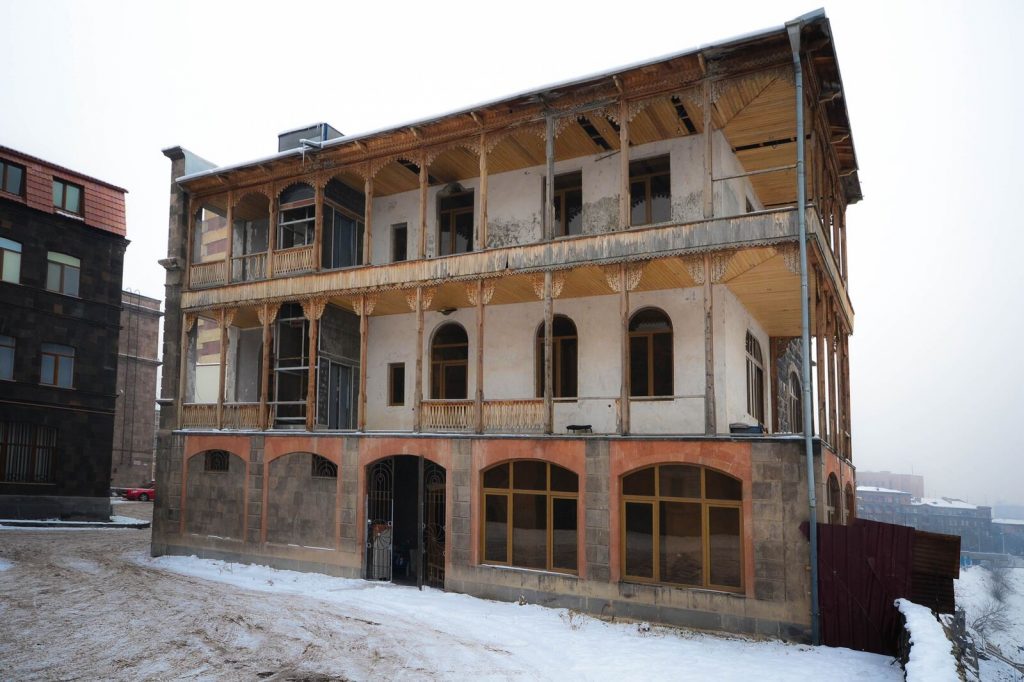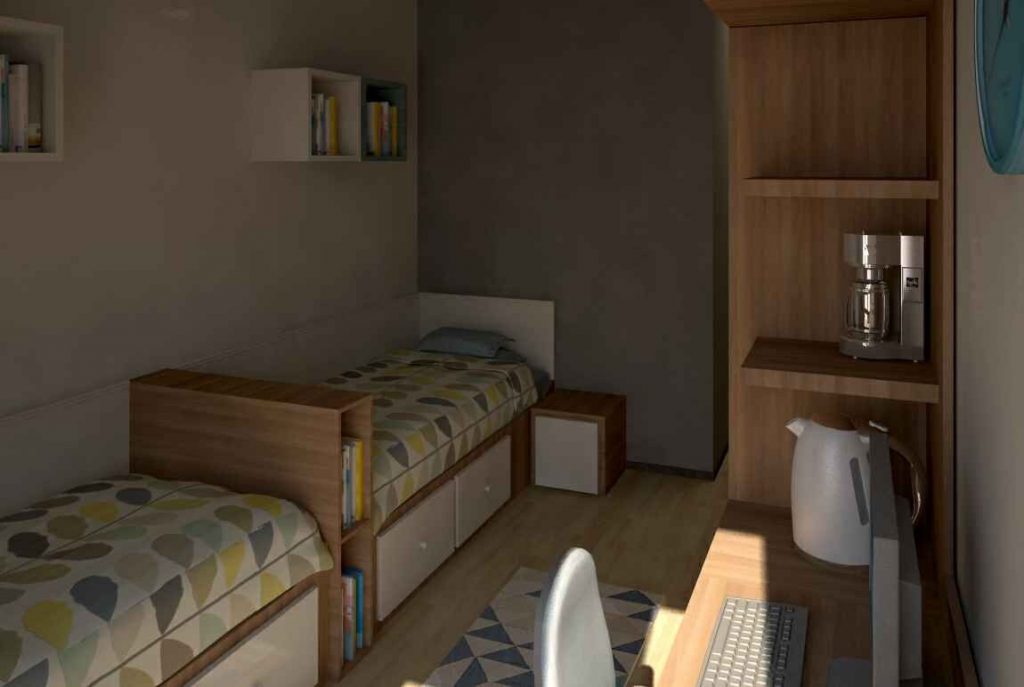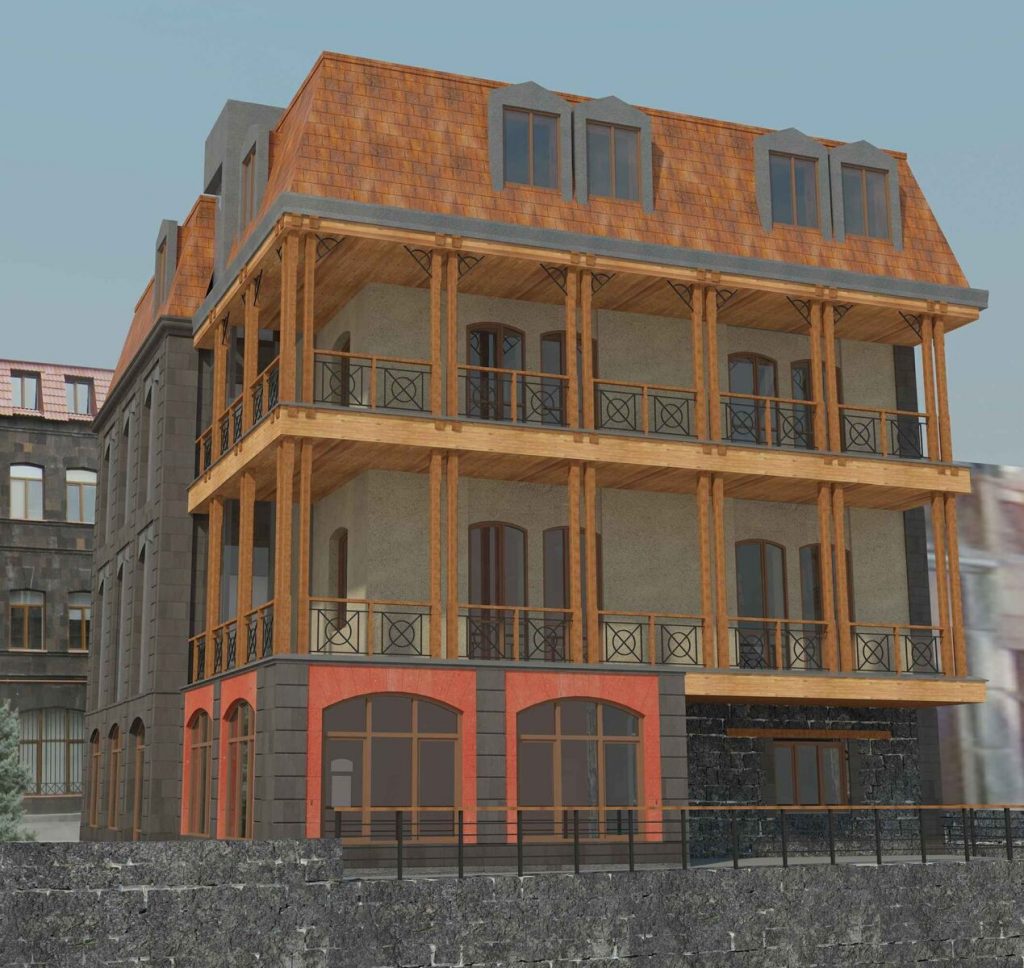YEREVAN—Last year, longtime philanthropists K. George and Dr. Carolann S. Najarian generously donated two impressive buildings to the American University of Armenia (AUA). The buildings, on adjoining properties in Yerevan’s Dzoragyugh ethnographic-cultural district, were part of a construction project initiated by the Najarians in the 1990’s.
The property overlooks the Hrazdan Gorge and is designed in an architectural style reminiscent of the late 19th and early 20th centuries. One of the two buildings, upon renovation, will be named The K. George and Carolann S. Najarian MD Building. AUA is currently exploring various ideas for its use. The Najarians have graciously agreed to allow AUA to name the second building, which is to become a residence hall, after a major donor.
A Long Legacy of Love and Support for the Homeland
Well known for their philanthropic work in Armenia since the days of the Spitak Earthquake and the Karabagh (Artsakh/NKR) Movement, the Najarians were approached by longtime AUA supporter, Aida Yeghiazarian of Los Angeles, who suggested gifting the buildings to the University. When they were first built, the Najarians had intended to retire in one and allocate the other as a center for NGOs, but they were thrilled by the prospect of donating the buildings to an educational institution that they feel is so integral to the development of Armenia.
The Najarians have a longstanding relationship with AUA, dating back to the mid-1990’s when Dr. Carolann Najarian lectured there on primary healthcare. The University’s School of Public Health had just launched at the time, and the concept of primary care in Armenia was practically nonexistent, so Dr. Haroutune Armenian, then the president of AUA, sought out Dr. Najarian’s expertise to help get the program off the ground. “I remember the days when AUA started out as an experiment to see if it could be done,” she recalls. Dr. Najarian and her husband have watched AUA prove itself and grow over the past 25 years.
The couple’s efforts in Armenia began in 1987 when Mr. Najarian took his first trip to Armenia, where he was profoundly moved and instantly felt at home. Shortly after, as the Karabagh conflict escalated, the Najarians became supporters of the Zoryan Institute. They went to Armenia in 1988 for the Cambridge-Yerevan Sister City Program. It was Dr. Najarian’s first trip. While there, Mr. Najarian took part in the massive pro-Karabagh demonstrations in front of the Matenadaran.
Shortly after they returned to the United States, Armenia was hit by the devastating earthquake. The Najarians had purchased a full back page spread in the New York Times concerning the Karabagh conflict, which was published, unfortunately, the day the earthquake struck, on Dec. 7, 1988, and thus failed to have any positive effect.
Dr. Najarian took a leave of absence from work, formed the NGO the Armenian Health Alliance, Inc.,and started getting shipments together for Armenia. She made frequent trips, realizing that she could work more efficiently if she were on the ground, assessing needs and distributing supplies. She partnered with the Armenian Ministry of Health, and through the Armenian Health Alliance, Dr. Najarian helped many of the hospitals in Yerevan and Gyumri where her primary work centered. Her husband became involved in building projects.
In 1992, Dr. Najarian took the first trip of many trips to Karabagh via helicopter. Three years later, working with the maternity hospital of Stepanakert and Mr. Gurgen Melikyan of Yerevan, they launched the Arpen Center, a feeding program for pregnant women in Karabagh. To date, the center has provided the mothers of more than 30,000 babies with vitamins, clothing, and other essential supplies in that region. Their efforts in Karabagh also included assistance to hospitals in Stepanakert and Kashatagh, to village medical posts, and the renovation of a 4th-century basilica in Kashatagh (Lachin Corridor).
Among Dr. Najarian’s noteworthy undertakings are two published books that are very near to her heart. A Call from Home: Armenia and Karabagh, My Journal, published in 1999, chronicles her personal memoirs from her humanitarian trips to Armenia from 1988 to 1998. She writes about the destruction she witnessed, the injuries and other medical problems of the people in Armenia and Karabagh, the people that she met along the way, the sometimes horrendous living conditions that she observed, and the travel problems which were regularly encountered.
In 2014, she edited the audio recordings of her father’s memoirs, publishing them in the book Avedis’ Story: An Armenian Boy’s Journey. The book describes how her father survived the Armenian Genocide by going into hiding with his mother and siblings, and escaping to Russia. He lived through the Russian Revolution and Civil War, managing to settle in America ultimately. The entire first part of the book documents Armenian village life as it was during the Ottoman Empire.
Her father remains the biggest source of inspiration for both the Najarians. Although he had no formal education, he loved to read about history and politics. He was a humanitarian and diplomat at heart who instilled in his daughter the desire to help others, which is why she chose to become a doctor. He was very concerned about human rights abuses and had escaped and survived the Armenian Genocide as a young boy.
“He would always tell me how important it was for an Armenian to be a citizen of the world, to be open to others, and to be concerned with the suffering of all groups,” remembers Dr. Najarian. The couple has endowed the Najarian Human Rights Lecture in conjunction with the Armenian Heritage Park Foundation in Boston. The lecture is given annually at Faneuil Hall.
Mr. Najarian’s father fought in the French Foreign Legion—a ‘gamavour.’ His parents were from the Kharpert region, in present-day Turkey. In 2007, the couple visited the region and saw that a Najarian Street still existed. According to his wife, “George’s goal in life has been to make money and give it away. His generosity is rooted in his belief that we should not help others when we are dead, but when we are alive.” They both want to enjoy the act of contributing to the betterment of lives and feel that supporting education is one of the best ways to do so.
When asked about advice for the future generations of Armenians both in the homeland and in the Diaspora, Dr. Najarian reiterates that the Armenians are a distinctive people with a long history they must be proud of and embrace. “We are a creative and strong people,” she says. “Our DNA has remained unique for a long time, and only recently it has begun to mix. My point is not to make us more ethnocentric. The question is, where do we fit in and what is or can be our contribution to the world? If we lose our uniqueness, that mosaic diminishes. Youth, both in Armenia and the Diaspora, need to understand that they are unique.”
For those in Armenia, Dr. Najarian says she hopes individuals will care more for one another within society, going beyond just the nucleus of friends and family. As for the Diaspora, she feels strongly about the new generation finding inspiration by taking part in programs that allow them to go and experience Armenia. Two critical examples she mentioned are studying at AUA and participating in Birthright Armenia.
Residence Facility: Ensuring Diversity and Inclusion
The residence hall project for one of the buildings donated by the Najarians recently received a significant grant from the Office of American Schools and Hospitals Abroad (ASHA), an organizational unit within the Bureau of Democracy, Conflict, and Humanitarian Assistance (DCHA) at the United States Agency for International Development (USAID). The goal of the ASHA program is to strengthen self-sustaining schools, libraries and medical centers that best demonstrate American ideas and practices abroad. The grant will allow the University to finish and furnish the building as a residence hall.
Accommodating up to 61 students, the residence hall will address the needs of AUA’s growing international student body and students from Armenia’s rural provinces by providing residential facilities with living-learning programs that typically exist in American higher education institutions. This addition to the University’s infrastructure will raise AUA’s profile regionally and internationally. The facility will be intentionally designed to promote student engagement as well as an appreciation of the American values of diversity. The communal living will allow residents to engage and appreciate cultural differences among international and local students. As mentioned earlier, this building is available for naming.
A Quarter Century of AUA
The American University of Armenia, established in 1991 with the purpose of introducing the American model of higher education to Armenia, is an institution of higher learning that provides teaching, research, and service programs that address the needs of Armenia and the surrounding region. It is affiliated with the University of California and is accredited by the WASC Senior College and University Commission (WSCUC). AUA celebrated its 25th anniversary on November 19 with an exclusive gala at the Beverly Wilshire, securing over $1.5 Million for vital scholarships.
AUA offers master’s degrees in nine fields of study: Business Administration, Industrial Engineering and Systems Management, Computer and Information Science, Political Science and International Affairs, Economics, Public Health, Law, Teaching English as a Foreign Language, and, starting fall 2017, Strategic Management. The University also offers bachelor’s degrees in English and Communications, Computer Science, Business, and, starting fall 2017, Engineering Sciences.
Please visit www.aua.am to learn more about AUA and ways in which you can support Armenia’s leading institution of higher education.
Source: Armenian Weekly
Link: Najarians of Massachusetts Donate Prime Yerevan Property to AUA






